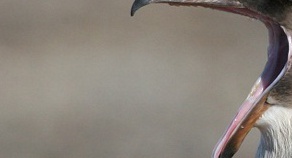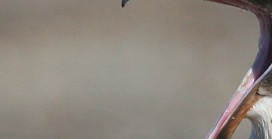














Mallory Lab - Acadia University
What we do ...
The Canadian Arctic
A truly magnificent and still largely unknown part of Canada is our Arctic, in particular Nunavut. This region supports more than 50 million birds during the brief Arctic summer (as well as the odd mammal and insect ...), including at least 10 million marine birds. Members of the marine bird group include the auks (murres, guillemots), fulmars, gulls, terns, and depending on your mood at the moment, the loons and sea ducks. Marine birds are strong bioindicators of the condition of marine environments, and thus we study aspects of their breeding ecology as an index of the status the Arctic environment.
Research in the Arctic has focused along several themes:
- Understanding marine bird breeding ecology
- Predicting the effects of climate change on marine birds
- Determining key marine habitat sites for marine birds and other wildlife using miniature telemetry technology
- Using remote sensing to identify key wildlife habitat, and assess temporal changes
- Examining contamination of food chains for marine birds
An area of research that has been particularly fruitful has been our studies on biotransport of nutrients and contaminants from marine food sources to coastal wetlands. This work has been in collaboration with numerous intrepid students, post-doctoral associates and colleagues, with chemical and limnological aspects led principally by Drs. Jules Blais and John Smol (see Links page).
We also have worked with local ecological knowledge (LEK), particularly that held by Inuit, as a companion to traditional, western scientific approaches to ecological research. LEK has been particularly helpful in guiding our work on endangered Ivory Gulls and on Harlequin Ducks.
Our recent work has expanded into new applications with remote sensing to locate marine bird colonies and link those sites to historical information trapped as proxies of environmental conditions in peat and lake sediments. As well, we continue to use new telemetry equipment to gain deeper insights into movements and habitats used by migratory Arctic wildlife.
The Canadian Maritimes
I have initiated research on coastal regions in the Maritimes, particularly in Nova Scotia, with collaborators at the Nova Scotia Department of Natural Resources, and Ducks Unlimited Canada. At the Beaubassin Field Station near Amherst, Nova Scotia, students have been studying the temporal phenology of aquatic macroinvertebrate abundance in different types of constructed wetlands, as it relates to waterbird use. At the same site, other students are examining bioaccumulation of trace elements in constructed wetlands and the aquatic food webs they support. At the Eastern Shore Islands, students are studying habitat change and populations of breeding coastal marine birds, from traditional breeding and habitat surveys, to examination of biotransport of trace elements and corticosterone deposition to eggs in different habitats. Around the province, another student is studying the genetics of Purple Sandpipers (Calidris maritima) to help determine phylogenetic relationships of this species across its range. All of these projects are tied to long-term monitoring programs, to help provide insights into patterns being observed in coastal habitats or species.
A truly magnificent and still largely unknown part of Canada is our Arctic, in particular Nunavut. This region supports more than 50 million birds during the brief Arctic summer (as well as the odd mammal and insect ...), including at least 10 million marine birds. Members of the marine bird group include the auks (murres, guillemots), fulmars, gulls, terns, and depending on your mood at the moment, the loons and sea ducks. Marine birds are strong bioindicators of the condition of marine environments, and thus we study aspects of their breeding ecology as an index of the status the Arctic environment.
Research in the Arctic has focused along several themes:
- Understanding marine bird breeding ecology
- Predicting the effects of climate change on marine birds
- Determining key marine habitat sites for marine birds and other wildlife using miniature telemetry technology
- Using remote sensing to identify key wildlife habitat, and assess temporal changes
- Examining contamination of food chains for marine birds
An area of research that has been particularly fruitful has been our studies on biotransport of nutrients and contaminants from marine food sources to coastal wetlands. This work has been in collaboration with numerous intrepid students, post-doctoral associates and colleagues, with chemical and limnological aspects led principally by Drs. Jules Blais and John Smol (see Links page).
We also have worked with local ecological knowledge (LEK), particularly that held by Inuit, as a companion to traditional, western scientific approaches to ecological research. LEK has been particularly helpful in guiding our work on endangered Ivory Gulls and on Harlequin Ducks.
Our recent work has expanded into new applications with remote sensing to locate marine bird colonies and link those sites to historical information trapped as proxies of environmental conditions in peat and lake sediments. As well, we continue to use new telemetry equipment to gain deeper insights into movements and habitats used by migratory Arctic wildlife.
The Canadian Maritimes
I have initiated research on coastal regions in the Maritimes, particularly in Nova Scotia, with collaborators at the Nova Scotia Department of Natural Resources, and Ducks Unlimited Canada. At the Beaubassin Field Station near Amherst, Nova Scotia, students have been studying the temporal phenology of aquatic macroinvertebrate abundance in different types of constructed wetlands, as it relates to waterbird use. At the same site, other students are examining bioaccumulation of trace elements in constructed wetlands and the aquatic food webs they support. At the Eastern Shore Islands, students are studying habitat change and populations of breeding coastal marine birds, from traditional breeding and habitat surveys, to examination of biotransport of trace elements and corticosterone deposition to eggs in different habitats. Around the province, another student is studying the genetics of Purple Sandpipers (Calidris maritima) to help determine phylogenetic relationships of this species across its range. All of these projects are tied to long-term monitoring programs, to help provide insights into patterns being observed in coastal habitats or species.
To date, our research is split between coastal habitats in
the Canadian Arctic and Maritimes
Copyright 2011 Mark Mallory
33 Westwood Ave, Acadia University
Wolfville, NS B4P 2R6
33 Westwood Ave, Acadia University
Wolfville, NS B4P 2R6
Website Themes by CoffeeCup Software
Mallory's Passion
an Icelandic Limerick Saga by David Newland
An indecent obsession with birds
Defies all description in words
A folly, a fashion
Call it "Mallory's Passion"
May yet be the death of some nerds
In the lee of Prince Leopold Island
Mark Mallory cried, behold MY land!
There, my flocks on the rocks
There, my home in a box
Precariously perched on the highland
The passengers murmured and mumbled
And with hefty binoculars fumbled
All for the sake
Of a few kittiwake
And perhaps the odd murre as it tumbled
Fulmars were glimpsed, and a raven
And other birds boorish, and craven
Gulls of the glacous sort
With cries of the raucous sort
Of which Mallory's known as a maven
But the wind that was Franklin's cold curse
Blew on our birders much worse
They uttered some words
About birds and their turds
That I dare not include in this verse
The weather grew snowy and storming
It seemed that a blizzard was forming
And fleeing the decks,
With scarves round their necks
The passengers cried out for warming
How they begged for a film, or a lecture-
Even half-baked concepts and conjecture
Anything but the sight
Of that godawful height
Pull the screen down, start the projecture!
To heck with ornithological
Narration so damn demagogical
We're all going stiff
Under Leopold's cliff
Just for glimpses of things ecological...
Mallory's passion's illogical!
an Icelandic Limerick Saga by David Newland
An indecent obsession with birds
Defies all description in words
A folly, a fashion
Call it "Mallory's Passion"
May yet be the death of some nerds
In the lee of Prince Leopold Island
Mark Mallory cried, behold MY land!
There, my flocks on the rocks
There, my home in a box
Precariously perched on the highland
The passengers murmured and mumbled
And with hefty binoculars fumbled
All for the sake
Of a few kittiwake
And perhaps the odd murre as it tumbled
Fulmars were glimpsed, and a raven
And other birds boorish, and craven
Gulls of the glacous sort
With cries of the raucous sort
Of which Mallory's known as a maven
But the wind that was Franklin's cold curse
Blew on our birders much worse
They uttered some words
About birds and their turds
That I dare not include in this verse
The weather grew snowy and storming
It seemed that a blizzard was forming
And fleeing the decks,
With scarves round their necks
The passengers cried out for warming
How they begged for a film, or a lecture-
Even half-baked concepts and conjecture
Anything but the sight
Of that godawful height
Pull the screen down, start the projecture!
To heck with ornithological
Narration so damn demagogical
We're all going stiff
Under Leopold's cliff
Just for glimpses of things ecological...
Mallory's passion's illogical!
